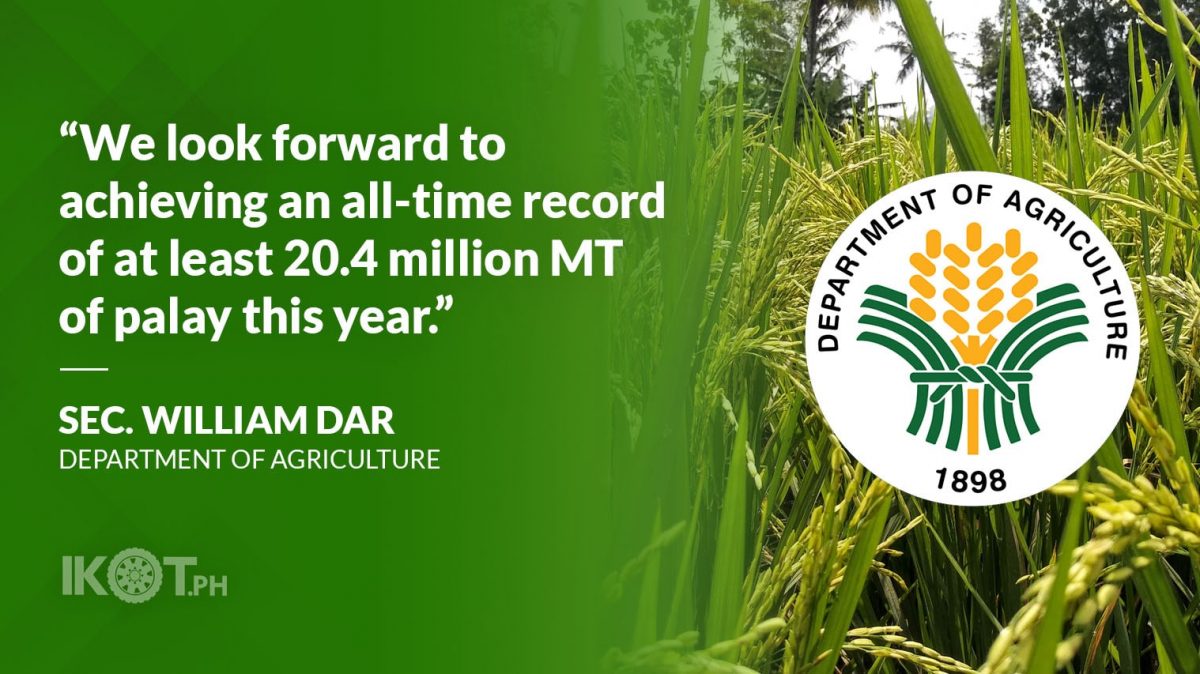More than two years since the implementation of the rice tariffication law (RTL), the country’s rice sector is gradually realizing its potentials, as both palay (paddy rice) production and farmgate prices are increasing this dry season, and more affordable rice for consumers amid the pandemic.
“To top it all, with sustained initiatives and strong cooperation of various rice industry stakeholders, we look forward to achieving an all-time record of at least 20.4 million MT of palay this year,” Agriculture Secretary William Dar said.
“The RTL is a transformative but disruptive policy reform. While we have anticipated transition to take time, the benefits that it brings to both consumers and palay farmers during this time of crisis cannot be denied,” Dar noted.
“Despite the pandemic, we are slowly but surely hurdling the challenges.”
“Despite the pandemic, we are slowly but surely hurdling the challenges in the implementation of RTL with tangible results in terms of palay productivity, farmgate price, and retail prices of rice,” the agriculture chief said.
“Rice is no longer the traditional driver of inflation. In fact, the stable supply of rice under the RTL regime has helped temper food inflation in the past several months, which continues to experience upward pressure from the tight supply of meat,” the agriculture head added.
For the current dry season, the DA through its Philippine Integrated Rice Program (PIRP) projects that palay production could reach 10 million metric tons (MMT), which is expected to extend in the next main cropping or wet season, as farmers are encouraged by higher farmgate prices.
“We expect the palay sector to continue its positive growth this year despite the community lockdowns.”
In a report to Dar, DA-PIRP director Dionisio Alvindia said they expect the palay sector to continue its positive growth this year despite the community lockdowns due to COVID-19 pandemic.
“The higher prices of palay at farmgate provide more incentives for our farmers to continue planting,” Alvindia said.
For instance, he said Nueva Ecija farmers were selling their freshly-harvested palay at P16 to P18 per kilo, and dried palay at P20 to P22 per kilo.
The optimism is buoyed by the latest report of the Philippine Statistics Authority (PSA), saying that palay production reached 4.57 MMT in January to March 2021, or 7.2 percent (%) higher than the 4.26 MMT recorded during the same three-month period last year.
The PSA attributed the gains to the increase in harvest area (1.1 million hectares) and planting intentions (85% of total area actually planted) during the period.
Alvindia said that at least 2 million hectares of land were planted to rice during the dry cropping season, with farmers producing an average of five MT per hectare, roughly one ton more than the national average.
To ensure higher productivity in the succeeding seasons, he said the “One DA” family is continuously working with farmers’ groups, local government units (LGUs) and industry stakeholders in the efficient and prompt distribution of hybrid and inbred seeds, provision of fertilizers, farm machinery and equipment, other production inputs, credit, and training and extension — all under the Rice Competitiveness Enhancement Fund (RCEF), rice resiliency, and national rice programs.
In particular, Alvindia stressed the RCEF program was able to provide the following interventions to rice farmers:
- Mechanization component – 9,236 machineries and equipment delivered to 3,180 farmers’ cooperatives and associations (FCAs);
- Seed component – 1.65 million bags (20 kg/bag) of certified seeds distributed to 661,567 farmers;
- Credit component – loaned a total of P2 billion to 5,956 farmers, and 97 FCAs, where 7,317 of its members are sub-borrowers; and
- Extension component – trained 226 specialists, 8,110 trainers, and 71,962 farmers, and established new 90 farm schools and enhanced 43 farm schools.

